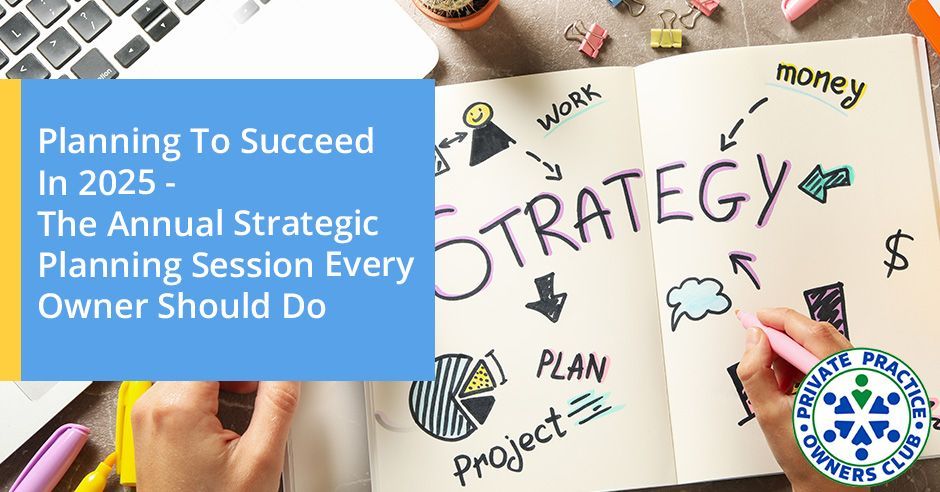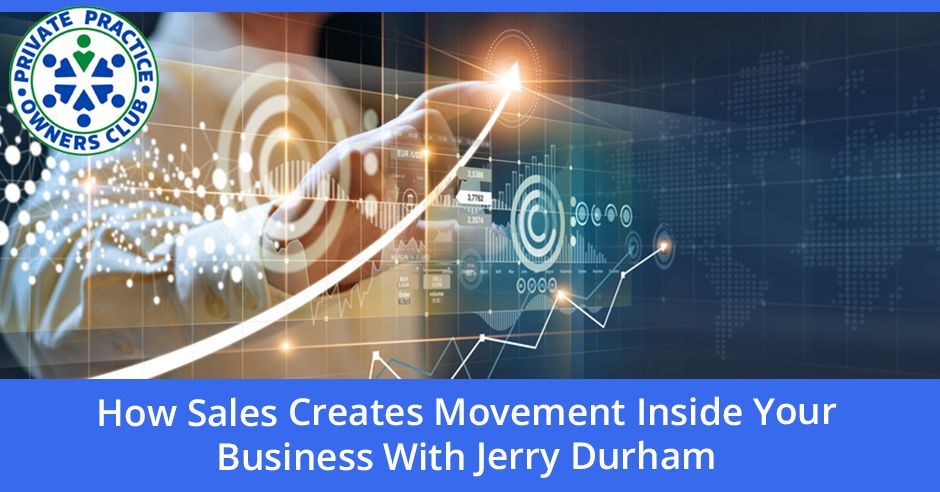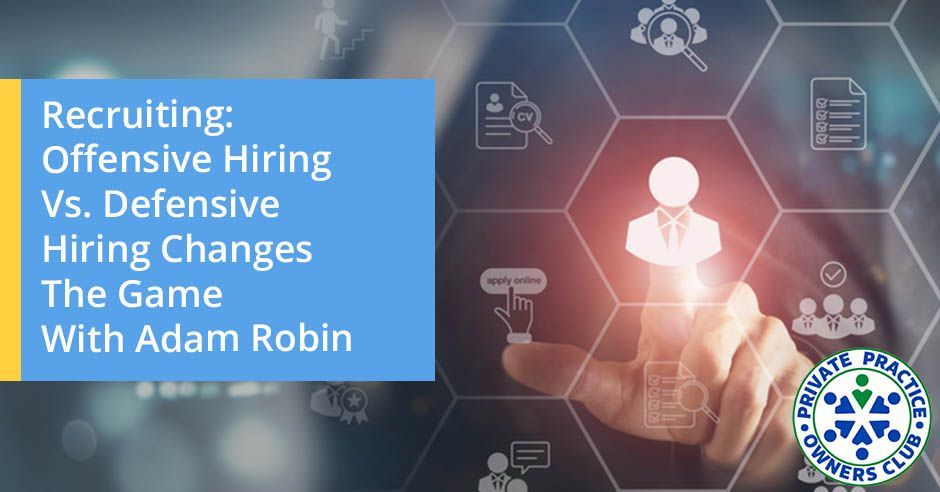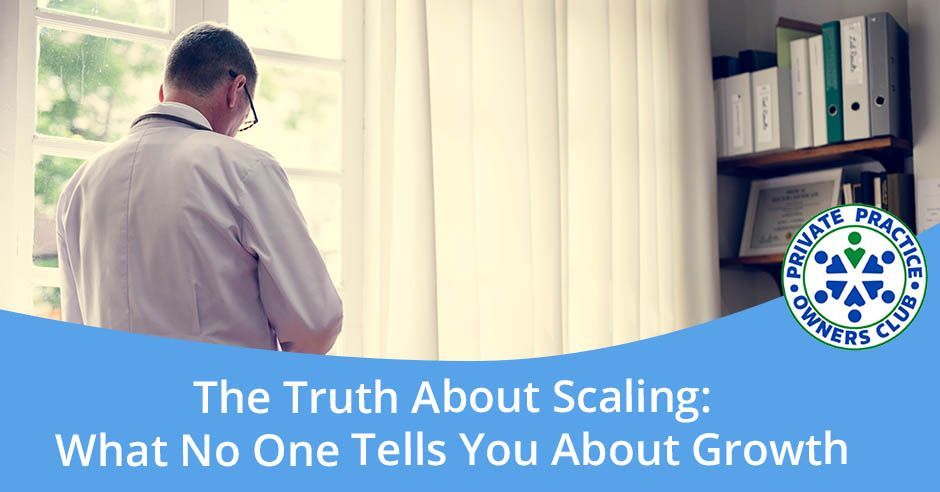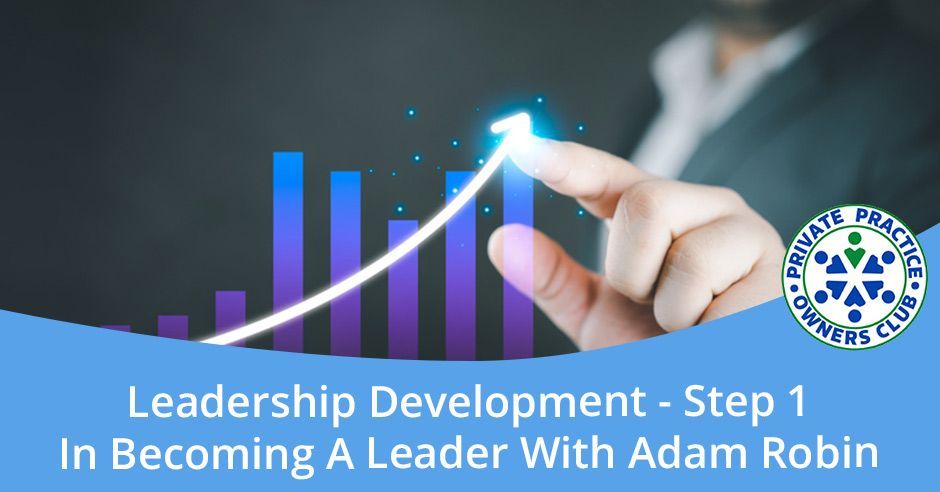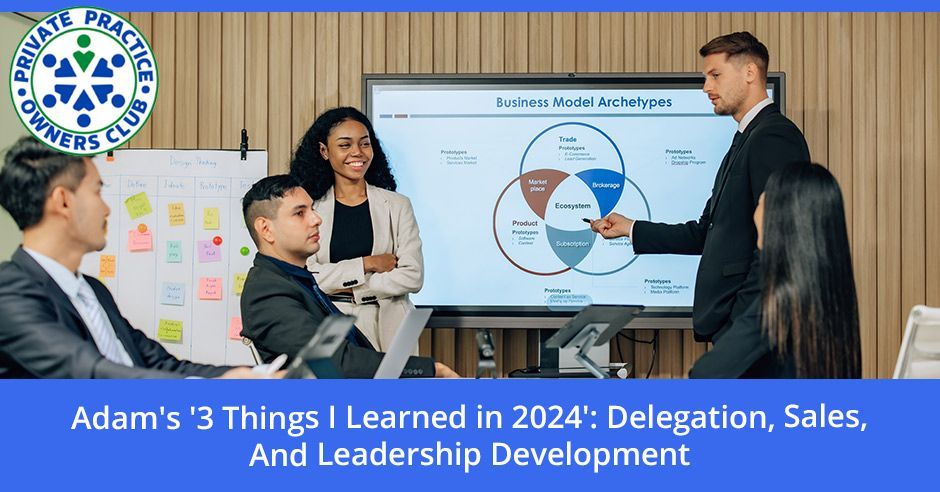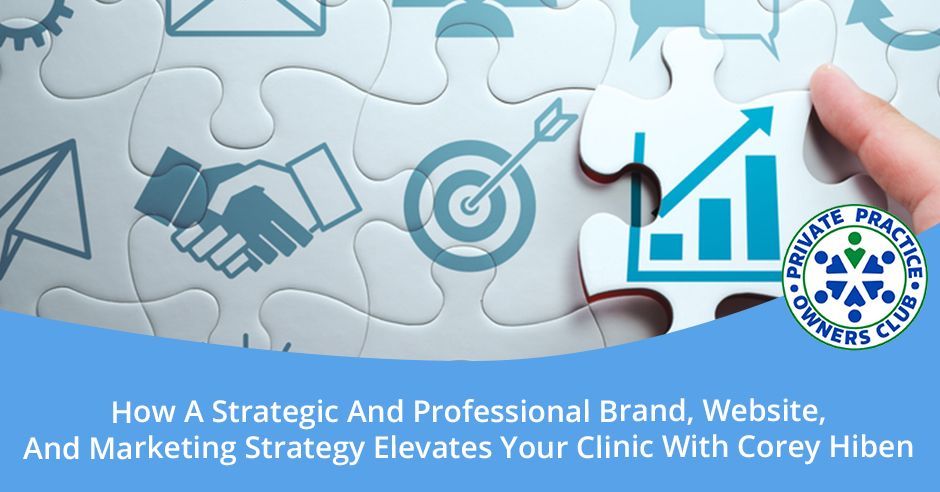Ready to turn 2025 into your best year yet? This Private Practice Owners Club Podcast will show you how annual strategic planning can bring lasting focus, alignment, and growth to your Practice.
Nathan Shields and Adam Robin discuss one of the most vital steps for Private Practice growth – annual strategic planning. This episode is packed with their experiences and actionable steps to ensure a focused, profitable, and vision-driven 2025.
This episode highlights:
- Why Q4 is Crucial for Success
o Nathan and Adam explain why starting now can give you a clear edge.
o Nathan and Adam reveal how a CEO mindset can help Private Practice owners stay on track and inspire their teams.
o Learn how strategic planning helps fight disturbance and keep your Practice aligned with big goals.
- Effective Tools and Exercises
o Nathan and Adam share practical tools to help you create a meaningful, actionable plan.
Don't miss this episode of Private Practice Owners Club Podcast – whether you're just starting or thinking about your next step in scaling your practice, this episode is packed with wisdom on to-dos, growth, and actionable tips for your Private Practice to succeed.
Interested in elevating your Practice? Visit https://go.ppoclub.com/linktree-podcasts for Free Resources, Avail Services, and Join the Group of Private Practice owners to connect and learn more about how to succeed in this industry.
Want to talk about how we can help you with your private practice, or have a question you want to ask? Book a call with Adam - https://calendly.com/adamrobin/dr-adam-s-30-minute-connection
Love the show? Subscribe, rate, review, and share! https://ppoclub.com
---
Listen to the podcast here
Planning To Succeed In 2025 - The Annual Strategic Planning Session Every Owner Should Do
We were anxious to get this episode down ASAP because we are in the fourth quarter of 2024. As we were talking about topics for the episode, there were a number of topics we wanted to cover. We still want to talk about the role of the CEO talking about break evens and highlighting other people who are succeeding in their companies and stuff like that, but it's quarter four, and we need to dive into what people are doing to address the new year because now is the time to prepare for making the next year, and then in this case, 2025 super successful.
If you think about the most successful companies in the nation or the world, they have probably already done all of their strategic planning for next year. We probably need to take a little bit of that magic and implement it into our small businesses and start focusing on what we want to achieve in the next year. That's why we wanted to put together this episode and get it out ASAP because now is the time. This topic is going to be along the lines of annual strategic planning, its importance, and what some of that can look like. Before we get into it, give me some of your thoughts about annual strategic plans.
Annual Strategic Plans
It's been awesome to be able to work with a bunch of coaching clients, talk to them, hear how they think, and get the most out of people. I have had a blast because I learned so much about the way people think. What I'm starting to recognize is that my opinion is that the most valuable skill that an owner or a leader can have is the ability to stop, plan, and then execute.
The ability to do that with consistency and to be able to deliver something meaningful with clarity to the team over and over is probably the best skill that you can have. I remember the first time you told me to do an annual strategic plan, I was like, “That's a lot of work and a lot of time and I don't want to do that,” but I did it anyway because you were a lot more successful than me, and you said, “You should probably try it and it was a habit of the successful. Once I committed to that, things that were one of the things that helped me did not transform my business but transformed my life and the way that I show up every single day. It's a powerful skill set and something that every great owner should consider.
They shouldn't just consider it. They need to do it. To speak to your point about talking with plenty of owners, these are small business owners, usually with relatively smaller clinics, but I'm sure there's a consistent personality trait that most of us who are entrepreneurial-minded have, and that is we have the shiny object syndrome and we will attack, address it, and maybe even carry it down the road a little bit. If we do that enough times, then our teams can get a little bit overwhelmed and be like, “What's the next new shiny project?” It’s because this will last another 2 or 3 months and then we are on to the next thing, so they are going to get some whiplash.
The beauty of the strategic plan is that it helps provide focus and direction. For the year, and ideally, you are not only establishing it in Q4 but then returning to it on a monthly basis at a minimum to be like, “What are our priorities and why are we introducing this new program if it doesn't fit? Let's stick to the plan. Stick to the focus and know that we have already figured out where the vision is. We don't have to add more to it.”
We know what that painting looks like in our minds before we start painting. Let's not add any of the strokes or colors. Let's drive the path that we have already designated. It takes a little bit of brain work on the front end. Some dedicated time to stop and make some decisions and then act, but once you take the time to plan, prioritize, and set the goals, that takes a lot of brain work out of the rest of the year. You don't have to find the next thing. You don't need to decide at the moment, “What do I need to focus on?” That was decided back in Q4 of the year before.
It saves so much time and energy, and if you have any measure of leadership, whether it's 1, 2, 3, or 4 leaders in your team and they are part of that planning process, now you have got an aligned team that knows where the company is going, and they are not reliant upon you to give them the vision day after day, week after week, month after month, with all the meetings. We have already bought into the vision that we established back in Q4 and that saves a lot of time and energy and brings complete alignment and focus from the team, which is super powerful. That's the beauty of it and it’s necessary to get predicted expected growth year over year.
It's a skill. It's like riding a bike. The first time you got on a bike, you didn't start popping wheelies. You sucked at it. Plain and simple. I don't mean to be harsh, but I'm an intense dude, but the reason why you have the shiny object syndrome and you get focused is because you suck at planning. You suck at focus. It's not because your business is special. It's not because there's something wrong with you. You are not used to using this type of thinking pattern and applying it to your business. I know that because we have all been there.
The first time you sit down and try to look at a piece of paper and flush out your priorities, it's hard. It's taxing because you have never done that before, but if you give yourself some time, put some training wheels on. Ride the bike around the block a few times. The next thing you know, you could take the training wheels off, and then the next thing you know, you can start popping wheelies and you can start doing all kinds of fun stuff, and now you are an expert and that is what a CEO does. That's what the skill set of a CEO is. You can get better at this. You don't have to be crippled by the shiny objects. You can dominate that stuff. You have to flex your muscles. Flex your thinking muscles in a different way.
Channel your focus. This practice of annual strategic planning was something that had never crossed my path for the first eight years of ownership until I had a coach/moderator who highly recommended it. You said I need two days with you guys and this is me and Will at the time. We are like, “What are we possibly doing here for two days?
Within the first, they were like, “We hardly covered anything. It was a deep dive into our business. All the opportunities that were out there. What are our strengths and weaknesses? If you have done this before, a SWOT analysis, but this is on a higher level. I used to do SWOT analysis and they would take me maybe half an hour to go through and fill out the different quadrants, but no. This was an actual conversation and also, the beauty of having the moderator in front of us to guide us and direct us was to challenge us.
If it's you, your team, or a partner, especially in the physical therapy world, you might be subject to saying, “So and so is happening simply because that's how it is. In Arizona, we are slower in the summer seasons, and we all come to accept it. No one challenges a song or something like that. Where a moderator's like, “Why do you guys have to be slow and the summer?” We have all the candid excuses and we'd throw them out there. He's like, “What if you found a way around that and instituted some programs?” We are left dumbfounded. We are like, “Yeah, maybe we should.”
Having that person to lead out on our strategic planning sessions was huge. He was all so sounding bored. He also provided feedback from his experience in a separate industry altogether where he came from. He wasn't used to the vernacular and Healthcare, but he provided feedback from a general business knowledge base, and it was huge. We had a clear roadmap of what we were doing next, and the fun part as we started developing leadership teams and invited them into these annual planning sessions, they got psyched because they felt special at that point.
They are like, “You are letting me peek behind the curtain and be with the special people to run this organization?” We are like, “You are a leader.” They are like, “Yes,” and they soaked that stuff up. When you get to the point where you have a leadership and team in place, and you do a strategic planning session, you determine your top 4, 5 priorities for the year.
The beauty of having your team is that they are now responsible for making sure those priorities and goals come to fruition by the end of the year, not you, the owner. You are able to now be the true visionary and cast the vision and maintain the course of the organization while your leadership team is leading the organization itself. Making sure those priorities and goals are being pushed down through the organization and that ultimately.
There was a real beauty behind that, but we are experienced in doing this. I don't want to be laborious, but we are talking a lot about it right now because so many people don't do it, number one. Not because they choose not to sometimes but because they don't know exactly what it is and what it entails. We want to stress the importance of it initially and how important it is, especially at this time of the year, but to get into it. Where would you recommend people start if they are thinking about having or doing an annual strategic plan? Planning session.
Strengths
The book Traction, Gino Wickman. We have referenced that book many times. Chapter three is the vision component and that can give you a very bullet-pointed, high-level view of what it might look like. That's a good place to start, but maybe even more important. That's one thing that I like to do and I don't know if you do something like this for you and your company. Towards the end of the year, mid-December, I like to go get out of Dodge. Go grab a room somewhere nice. Maybe it's the mountains or the beach or whatever it is, the lake. You and your spouse.
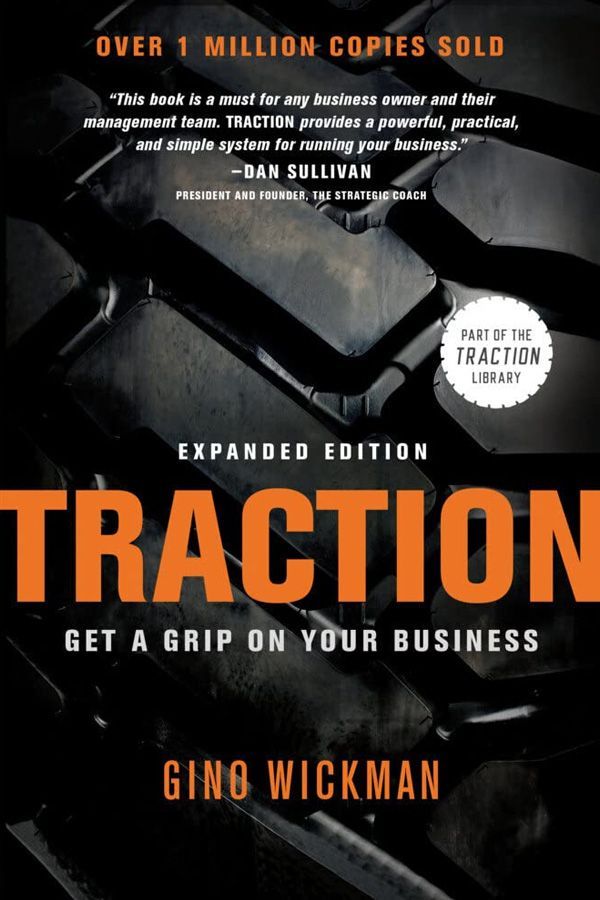
Go out there and decompress and dream a little bit. “What will be fun next year? What would be exciting?” Being able to separate yourself from the heaviness of the day-to-day in your business and to give yourself permission to start dreaming about what might be possible can give you the inspiration to step into an annual strategic plan with a lot more excitement because you can start seeing what might be possible. That's what I like to do. I'm not saying it's right or wrong, but that's a good habit to get into if you are a leader.
You bring up a great idea and it's very normal for these types of sessions to be offsite. Not in the middle of the clinic. During a busy day, we did the same. Will and I went to Vegas, where our moderator lives. We flew to Vegas, where we did our annual strategic planning sessions even though our clinics were in Phoenix.
Eventually, we'd find we'd have him come to Phoenix because we had a leadership team, but again, it wasn't in any of our clinics. It was offsite. We got it catered. We made it nice. Having it separate so you can have that mental separation is a big deal and you have nothing on your plate. Another point that you brought up in the separation is maybe turning off the emails for a day or two while you are going through this and letting everyone know. “I'm off the grid for a little bit, so you don't get sucked back in. You can maintain the space, and the bandwidth to focus on visionary. That's a big part of it now.
That's when it's important to start with. This is what you usually start. What were some of the huge wins from the past year? What did we do? Let's list at least 3 to 5 things where the huge wins that we made. What's the progress that we made? Can you write those down? What were some of the things that we could have done better? Let's take some general ideas and put them out there where there are some values that we didn't quite live up to. A good values alignment check is always good that we live this value. How did we do on that value? How are we doing on our purpose? Are we measuring up to the purpose that is stated? Annually, at least, is it a good time to? Status check your purpose and values. Are we on the right track? Are we doing the things that we say that we are going to do on a regular basis? That's a good place to start by reassessing the previous year.
What they say is that experience is not your greatest teacher, but it's the experience that you reflect on and debrief. It's your greatest teacher. It's like, “That's not a cliché. It's real life. It's true stuff.” Let's do it. There are many that go on notice every day, every week, and every year. There are so many wins that go on notice and there are so many million-dollar nuggets inside that you are not capturing. We hit an all-time record. How did we do that? What were some of the things that led to that? What were some of the key decisions that we committed to that might have contributed to that? Great idea to get that on paper. What are the SOPs? Maybe we can add that to the onboarding process, as so many things can get created by analyzing those wins.
Experience is not your greatest teacher but it's the experience that you reflect on and debrief.
Why didn't we celebrate that?
I have been treating 80% of patients a week.
How did we not do anything about it? We are so focused on the failures and what went wrong and those things get highlighted because they stand out, but we don't capture and celebrate our wins enough, and I love the point of that. From there, then it's easy to say. “What does the ideal scene look like for the end?” One of the strategic coach's questions is, say, we are sitting here at the end of 2025. What has to have happened for us to look back and say this was a completely successful year? What has to have happened to make us completely satisfied and say, “We achieved some amazing things.” Let's write some of those things down. What's that ideal? What does that ideal scene look like?
We need to be true for us to knock it out of the park. I love that question. What a great question. They say the quality of your impact is based on the quality of questions you asked and we are never asking ourselves those questions ever.
The quality of your impact is based on the quality of the questions you asked.
We are not diving deep enough.
That's fantastic.
That's a great place to start. It's like, let's dream big. Let's build out a BHAG if you will, Big Hairy Audacious Goal. Let's dream. Let's imagine things go great. We can expect some challenges, but in the end, let's imagine it being an amazingly transformative year. What does that look like? That's a good place to start.
You mentioned a dream. I want to make note that it's important to dream without limitation. A lot of people get in there, and they say, “Yeah, but,” no buts. What if all things were true? What if we could do anything? What if we had a magic wand? Let's get out of the realm of what you think reality is for a second. Let's think about abracadabra. What can we do? We can transition into like, “What do we need to be true to be able to do that?” That's a different conversation. Making sure you are distinct there is important.
This is a time to brainstorm and in a brainstorming session, you never want to shoot anything down. I'm the one that falls to the side of caution. I would love to say, “We are going to average $175 a visit.” That might be a little bit too much. Let's say $130. That's not the time to do this. Let's not be super realistic. Let's push the envelope a little bit right and have some fun with it.
Weaknesses
From there then, you can start talking about and this is where we go. I'm taking you through a little bit of the exercises we go through and then we start to talk about a SWOT analysis and that is we will talk about our strengths. What are we known for? What are we getting feedback on? Why do people love us? Who are some of our people who have strengths? What are some of our systems that are amazing? Who are some of the vendors that we lean on that have been incredible? Let's list out all those strengths so we can recognize them. Maybe in the future, within this exercise, we can leverage those things, and so it starts with the strength portion. After that, then you can go into weaknesses. Let's be clear where we are weak.
Sometimes, those are harder to do.
They are harder to get clear on. As part of this conversation, one of the rules that we had in our meetings, especially during the strategic planning sessions, was that there should be no pink elephants. No pink elephants is another way of saying no 500-pound gorilla sitting in the corner of the room.
Maybe that's why those are hard to find because sometimes there are some things that need to be talked about but that aren't being talked about because somebody might think that that's a weakness, that's an attack, or whatever and those are hard to face sometimes.
What are the five dysfunctions of a team? One of those is having open and honest debate and conflict. Conflict might be the wrong word, but to show you how we put it into practice before every leadership meeting, we would go one of our exercises, “Pink elephants time. Is everybody clear?” We go one by one, and each person has to say yes. When they say yes, that means I don't have any current issues with anyone here in the room, and what has happened recently would cause me negative emotions amongst us. We are all aligned. We are all good.
Sometimes people need to say no. This is the time to point fingers and say, “You said this and it felt condescending or felt like I was being preached at and it hurt. It felt like I was being talked down to and I didn't appreciate that. I know I have some things to work on and I'm sure you didn't intend that to be that way.” That's what I mean by pink elephants and we have to flesh those out before we move forward into any of these conversations. If you are going to talk about that during a SWOT analysis and the weaknesses of the organization, that's the time to pull back the curtains, expose yourselves, and say, “This is what's wrong with our organization.”
Pick some things. We suffer from people who come in late with no disciplinary action whatsoever. It goes against our values. We know it goes against our values, but we don't take any of them into account. That's a huge weakness. That's the time to be honest and open about the weaknesses of the organization, or honestly, this is a time when the owner might have to be vulnerable, quiet, and shut the hell up.
Here's the truth. You are a reflection of the organization. The weaknesses are there because you have allowed them to be there and they have gone on notice by you because you are the leader and it's hard. It's hard and I have been there. For me, some of the weaknesses. To be vulnerable with the readers, like too many ideas and not enough clarity like, “We have a lot of ideas here in our company but not a lot of clarity.”
Did they say that to you?
Those were some of the weaknesses that we had to overcome. You guys have known me long enough to know that I have a lot of ideas and sometimes not a lot of clarity. That was a direct weakness of my leadership capabilities, and I had to hear that and get better at that. We had to implement some systems to get them and check. I feel like I'm so glad and grateful for that opportunity to be able to do that and to help the team and company get better.
What did you have to do to get your team to a point where they felt safe enough to say that?
In Traction chapter three, in the back, there's a leadership exercise that states that everybody's going to go around the room and tell each other one thing that they love about each person and one thing that they wish would be a little different, and we did that. It was hard, but you know what happened? Everybody said the same thing about everybody. It was a super powerful exercise, and it was tense, but you have to do hard things if you want to grow.
You have to do hard things if you want to grow.
You’ve got to have those discussions, especially with the leadership team. You have to have that, and a good moderator will tease some of it out. Our moderator, back in Vegas, met with some partners. He shares the story, and it's happened a couple of times where he brings up the idea of pink elephants within the first five minutes because that's one of the rules. It's like all phones or turned off. There's nothing else scheduled for the rest of the day. Everyone's going to be engaged. Be the first to share from experience, but no pink elephants is another rule and he explained the no pink elephants issue. They spent the rest of the day arguing and fleshing things out.
I know the weaknesses of the company.
I know the weaknesses of my partner.
Bad communication, leadership, and culture.
Exactly, and it was all about their relationship as partners. He's like, “We are not going anywhere until we figure this out because the company is not going anywhere until that's figured out.” It's a vital part of the entire analysis of the organization, and frankly, if that had to happen, You have got to let it go. If we have to spend the next 4 to 6 hours talking this stuff out, let's talk it out now, instead of being poisoned that seeps and cankers us for the rest of the year. Let's get it out.
Opportunities And Threats
Talking about weaknesses, including the pink elephants, is a huge step towards any leadership growing close and functioning well together. Opportunities. Pretty straightforward. What opportunities are laid before us and the next year that we can take advantage of? This includes some of the ideas that we have to implement over the next year. “We have got this available to us and that available to us. These opportunities are over here. We can strengthen this department. This software program is going to make a huge difference.
The threats. Internal threats can be external. We talked about those as well, thinking declining reimbursement is an external threat. So and so is going to have a baby this year. That could be a hit to the organization. There are things like that you want to get out to put on the table ahead of time. Just so you can look forward and say, “These are some things we might have to consider planning for.” That's the idea. Give you some time to look forward so that you aren't reactive but proactive.
The one thing that we did that was fun was we made a SWOT Google form and we sent it to every person in the company. Sixty people did a SWOT analysis. Some did it. Some didn't, but that was helpful to be able to pull that up and see the insights of the team. It was cool.
There's going to be a ton of opportunities and a lot of people are going to say the same thing. There's going to be a number of weaknesses and a lot of people are going to say the same thing. They might say it in different ways. The idea of listing out all the opportunities and threats. In the first exercise, the first thing we do is reward those threats to make them opportunities.
If you said declining reimbursement, that's an easy threat. That's going to impact our profit margins next year. Declining reimbursement from insurance companies. An opportunity would be to improve internal systems and contracts such that our reimbursement rate increases instead of decreases. You don't have to go into the details. Let's say an opportunity could be to find ways to increase our average reimbursement rate. Let’s make it a succinct and simple knot, tying it to anything in particular. That would be a good way of changing a threat to an opportunity, and you do that with all the threats and change them into opportunities.
You also want to cross out any of those that are saying the same thing essentially. Reword them, whatever that takes, and then. You have a list of twenty opportunities because those threats were reworded to become opportunities along with the original list of opportunities. Now, you have got a good set of 15 to 20 plus opportunities before you have to attack the new year. Now, what do you do with it?
The one thing I want to highlight there and I think it was Carl Jung who said, “Wherever your fear is there is your project.” Most people out there, are these threats right, or these big scary challenges that you know are up there on the shelf, but you are not looking at them because you don't want to face them.
Another great reason why this annual strategic plan is so useful is because it forces you to put them down on paper and attack the problems that you are most worried about. Reimbursement, recruiting, all the things. It forces you to switch into solution mode as opposed to like, fear and insecurity, and just, “I'm a victim. I can't do anything about it.” That's false because there are a lot of things around those challenges that you can control. You have to be willing to step out and think about it.
Goal Setting
You have this list of twenty-plus opportunities. Now, the conversation between you, your partner, your leadership team, or between you and the moderator is, “What are the five we are going to work on this year?” All twenty of these are going to show up some time along the course of the next year, and how are you going to determine what the top five are if you don't do it now? Now is the best time because you are supposedly in a dreaming state. You are in a positive, optimistic state.
You are looking forward to it. You are excited and you are thinking everything is possible. What are the 4 or 5 that we are going to focus on this year? It takes some time. Do we want this? Do we want that? We say we want it, but do we want it? Is that going to make a significant impact or not and start crossing them out? Does this opportunity sound a lot like this opportunity and can be rewarded, so it's one thing? At that point, one thing is still important. It's a lot of work to win over it down to 4 and 5 and some people might be the flag bearers for some of those priorities and they have to fight against the other flag bearers who were saying, “I don't think so,” and again, the conversation has to ensue and so you can get it down to 4 or 5.
Prioritization. We talked about what it does for the alignment of the team. This is where that comes into play. This is where the rubber meets the road because we have all agreed after we have done this. These are the company's top five priorities, and then you step back and like, “Are we good? Is this cool?” If this is what we believe are the top five, are we agreeing that nothing distracts us from these top five? Celebration time, we are clear that this is what we are going to focus on going forward. That's when it starts.
That's the execution stage.
You then start talking about execution. This whole process usually takes from start to finish. It only takes me an hour or two at the end to fill out the rest of it, but the first 4 or 5 hours or so.
It's a full day. Depending on how big your company is, it's at least a full day. We had two people in our company when we had this coaching company and it took us 4 or 5 hours.
I did this in 2023. We got a place, an office suite in Tempe. Nice view and a nice place, and we went to lunch and came back and had to finish, though. I'm sure it was at least 5 to 6 hours for just the two of us in a small organization. It took some time, but after that, now you have your priorities. Now, we can establish the goals related to each priority. Goal setting back in the day for me, “I just wanted this goal.” I will just write that down. Not necessarily tying it to any priorities. Now you have the priorities. Now, let's cast the vision. What does the end goal of this priority look like? What is the finished product?
What's the definition of done?
What is it? Iterate that and then set a year-end goal for it, followed by some benchmark goals behind it. If it's going to take the full year, some of these goals might not take a full twelve months and that's fine. Put an end date for them, but if it's your end goal, where do we need to be at the end of quarters 1, 2, 3, and 4? Let's figure that out now. These can be adjusted along the way, but let's figure those out now and make sure we have a clear idea of what the path forward looks like.
I think it's incredible. Hopefully, most of us have experienced the excitement that you get whenever you find a lot of clarity and direction. When you start to recognize, “I do have a plan and I do have some control over this.” The overwhelming anxiety turns into excitement and empowerment. Once you get good at finding that, you get good at finding that type of clarity.
First of all, your team is going to start expecting it. It's going to be an expectation moving forward and you and your team will get better at finding that throughout the year during your weekly team meetings, your monthly debriefs, or your quarterly. You will learn the skill of finding clarity as a team, and I feel like I can't stress enough how powerful it is and the truth is because this is the premise of our entire coaching program. It is that you and your team are the answer to all your problems. You have got everything you need to do anything you want in your practice. All you need is clarity. When you find clarity and direction, you will unlock everything you ever wanted and that's why I'm passionate about that because things get exciting. I like seeing people win.
I'm sure walking away from this exercise and going through it with your team. What has been their response after doing it?
Just excitement. We do our one-word open, and then we do our one-word close. My favorite thing is whenever one word is open, it is busy, and one more word is close, which is exciting. It’s like you transform that mind. You empower your team. I'm ready. I'm excited. I'm ready to go.
I'm doing this with other companies, and I have done it with our organization, other PTO owners, and even with Will’s billing company and all of this Bullard, his leadership team. The energy afterward is awesome.
We have got something up, so let's rock and roll.
We hammered out some of the issues that we felt we were having, and we have a clear idea of how we are going to address the obstacles before us. That sense is powerful.
It's the most powerful thing there is.
I'm not a victim of that anymore. We have an idea of how to address it. So and so is going to lead the charge and I'm going to support them 100% and give them everything that they need to achieve their goal, and even let her or him delegate things to me as needed to accomplish that goal. I'm ready to go and super excited as an owner, especially to know that your teams are on board, that you have a clear vision of what's going to happen, and that it's not dependent upon you.
Are you sure that we shouldn't do some more Facebook ads and let that be the problem? Let’s do more Facebook ads in 2025.
Double our Facebook Ad budget.
Let’s just run some ads and get more new patients. That's going to solve everything.
That will solve it all. Great things happen from it. I have had plenty of people that are working with me on that. For those who are reading, we are saying this to give you some guidance, but all so saying this because you need support, and don't be afraid to reach out to us to get that support. We will come on-site and guide you through this process. The annual strategic planning process to make it a win for you and your organization.
The beauty of having that third party, someone that's outside of the organization leading that process, is that I have already talked to a little bit because there's not that internal understanding of excuses that you have built in. Someone who also can challenge the CEO or owner because typically, your team's not going to speak up and go against the owner, but if a moderator is doing the right thing and seeing things go sideways and feeling some uncomfortable pauses, we will speak out and say, “Anyone feels differently about what the owner said?”
Did anybody hear that elephant come around?
I’m hearing some pink elephants walk in the room. Give them a voice because, unfortunately, when the owners present, their voice stands out more than the others, and they will defer to it. Even if you don't have a leadership team, it's helpful to have the feedback, the guidance, the pushback on occasion, and the accountability. Do you think you are going to do that? The hare-brained idea, that stuff can be helpful and we can come on-site and do that for you guys, for sure. Anything else you want to share about strategic plans?
No. If I get on a call with you and I ask you what your top three priorities are for the rest of the quarter and you say, “I don't know.” Shame on you.
It’s because you didn't do this.
You didn't plan. You are not clear on your priorities. Our clients are destroying the game because they stay clear all year long and you can too. I would encourage you that there's way more possible for you.
One of the things about having that set in place, now we have determined everything. If you can now present your top priorities to your coach, guess who's going to hold you accountable? Does an owner have someone to whom they are accountable? Maybe they are accountable to their spouses and their family. Sure, but their spouses and their families aren't typically in question about their everyday business decisions. They want to make sure everything's safe and secure at home. That's where the coach comes in and says, “You said this was a top priority and you are not doing anything about it. Tell me what's up.”
More pink elephants.
That accountability is absolutely necessary, and if you don't have a coach to hold you accountable, I don't know how many more times I can tell you.
You got to, you got a crazy person at the wheel.
I have been doing this for several years, and I don't know how many episodes I'd go without saying, “You need a coach.” It doesn't have to be me. I don't care. Get a coach. If you are going to have a coach, at least present to him, “These are my top five priorities for the year. Can you help me achieve them?” Do the priorities. Get a coach, and then you will see a transformative difference in your business.
I practiced for ten years before getting a coach, and I can promise you my revenues and profits were flatlined for the previous years, but once I got a coach, my life vastly changed and the trajectory of my life altogether changed simply because of that decision. It will be the same for those who are reading that haven't gotten the coach yet. Huge challenge out there to get one, especially in this next year, 2025.
It can be the biggest one ever.
That's right. It can be. Thanks for joining me again. Exciting times.
Yes, sir. Let's do it again.



